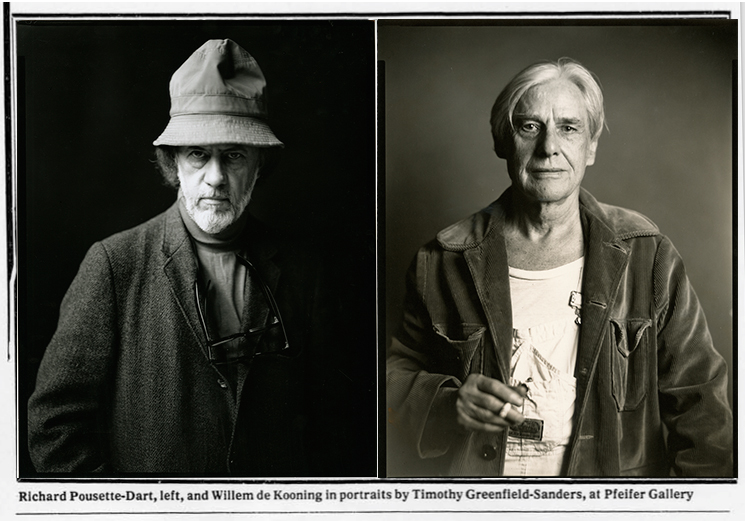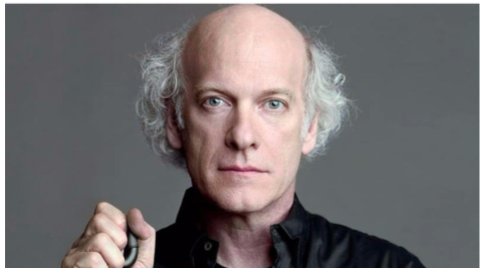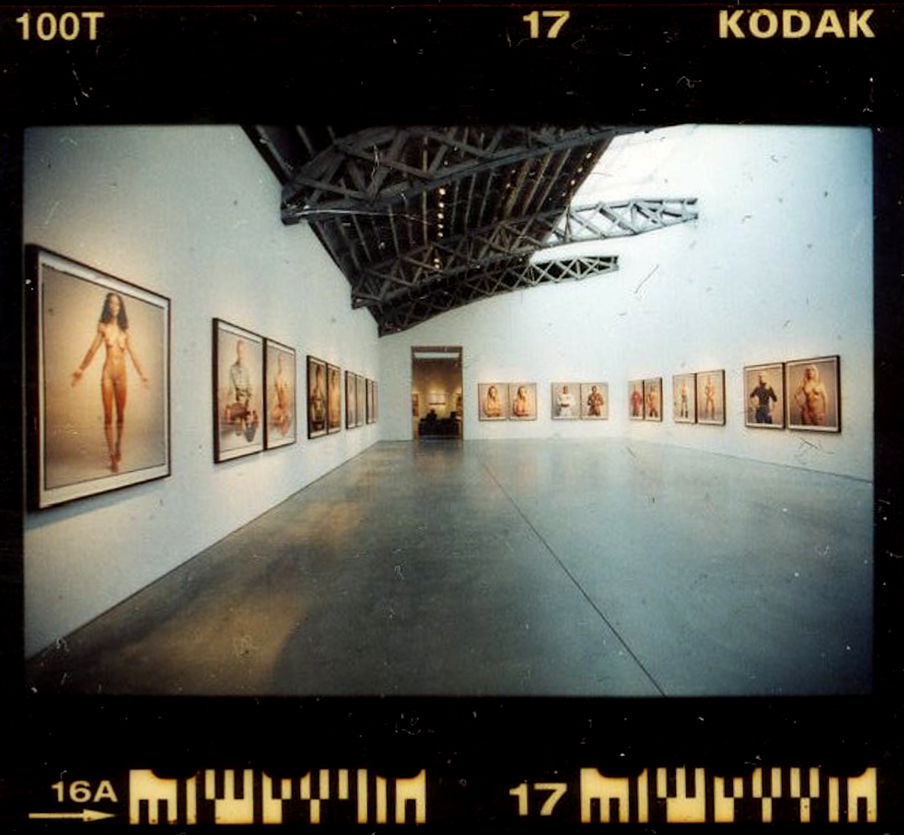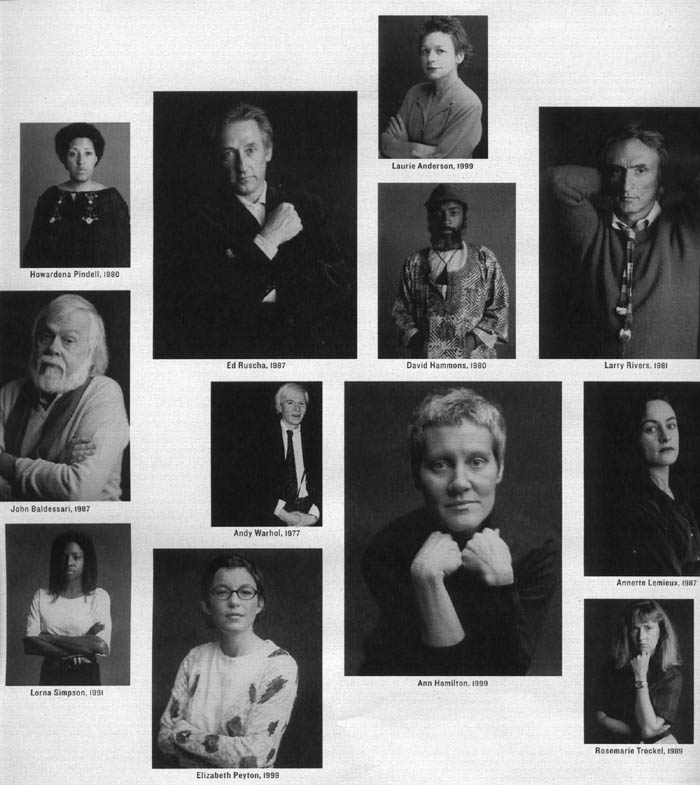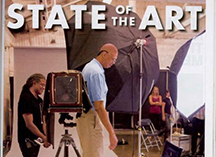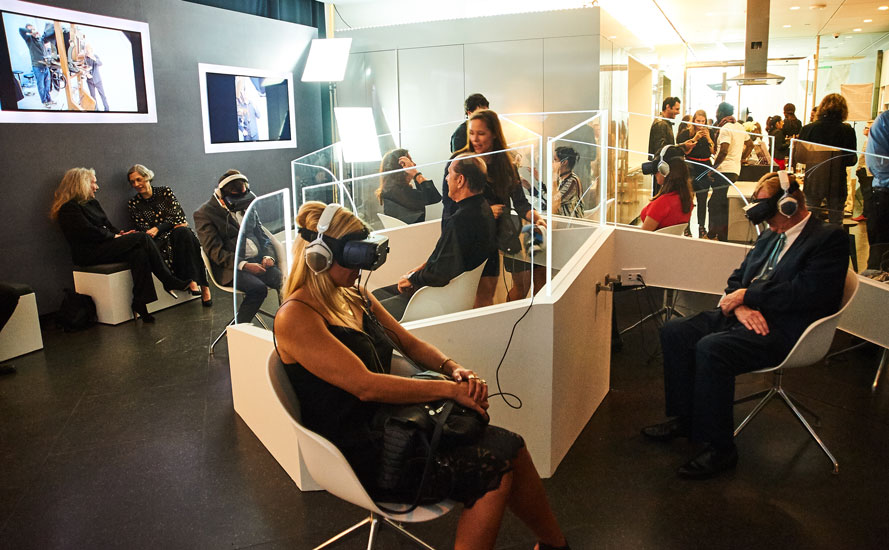ArtNet, Photography, Critical and Sycophantic – by Jeremy Gilbert-Rolfe – 2000
—
What I like about Timothy Greenfield-Sanders’ photographs is that they do two things at once. They present one as one wants to be presented, but they also show what it is about oneself that one’s friends secretly find ludicrous. That is what one wants from portraits. All the best portraiture captures what it is about the subject that he or she knows to be absurd but expects the world to tolerate, or doesn’t care if it doesn’t. Ingres’ painting of the Comtesse d’Hausonville (1845) exemplifies this, and Rembrandt does it to himself in the late self-portraits, especially the one where he’s wearing a white turban. There must, I feel, have been close friends of Baudelaire who burst into laughter on seeing Nadar’s photograph of him for the first time.
Recently Greenfield-Sanders’ photographs of people in the art world were shown together at Mary Boone gallery in New York, and subsequently published in what I am told resembles a school yearbook and is called Art World. Art World is divided into the institutional categories through which the art world sustains itself: artists, dealers, collectors, curators and directors, and critics. This arrangement seems right for the times. It begins and ends with those most immediately concerned with art, and those who hold power hold these two groups apart.
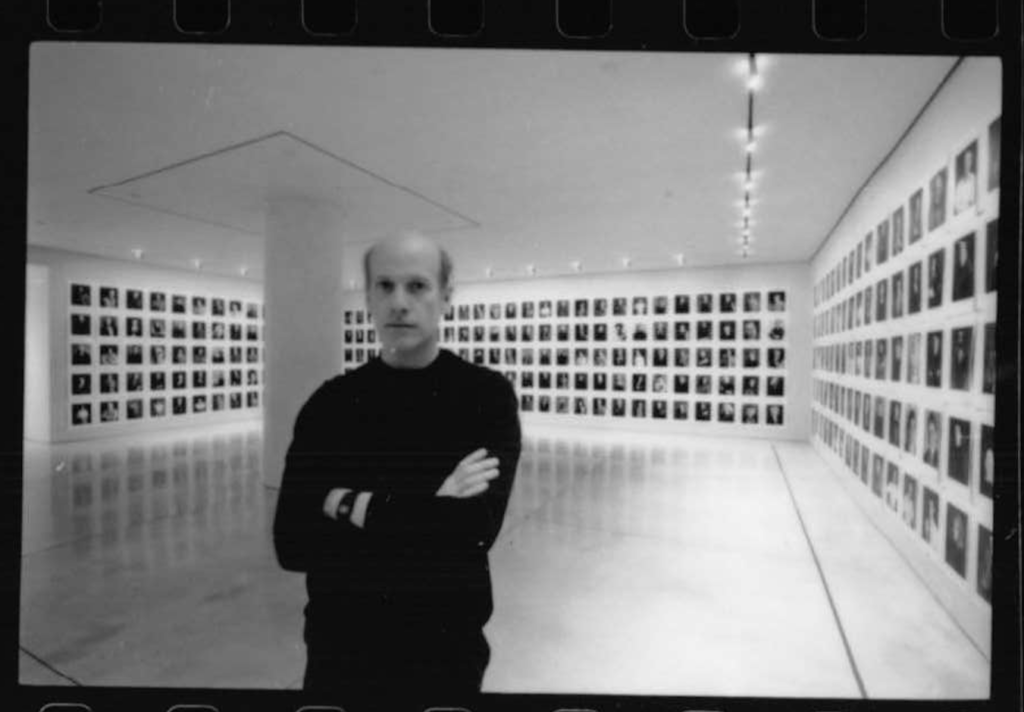
Because photography records something that therefore must have happened, the pleasures of the photographic are always related to an idea of the truthful or its companion and complement, the fantasy. As one leafs through the book and sees so many old friends, and other faces familiar although not on a personal basis, one is struck by truths that are not surprising — surely a guarantee of its documentary worth.
The collectors’ photographs seem quite individuated, as one would expect given that they are united only by what is for them a leisure-time activity. The dealers, directors and curators similarly range from the playful (e.g., Paula Cooper and Leo Castelli) to the implausible (Jeffrey Deitch), although here one may discern a more limited menu of postures.
This menu is even more sharply sparse at either end of the book. As is now traditional, the artists all look critical while all the critics look artistic, and within these options there are broadly speaking only two postures available to each group.
For the artists there are the options of warmer than cool (Nancy Haynes) or cool (Rebecca Horn), while the critics perform their own customary choice between the 19th century as such or 19th-century versions of popular culture. Thus Leo Steinberg has arranged himself to resemble a Victorian re-enactment of a 17th-century version of a Titian, while Robert Pincus-Witten (one of the few allowed, or inclined, to smile) has had himself done as a fashion photograph built around doing something suggestive with the finger of a glove.
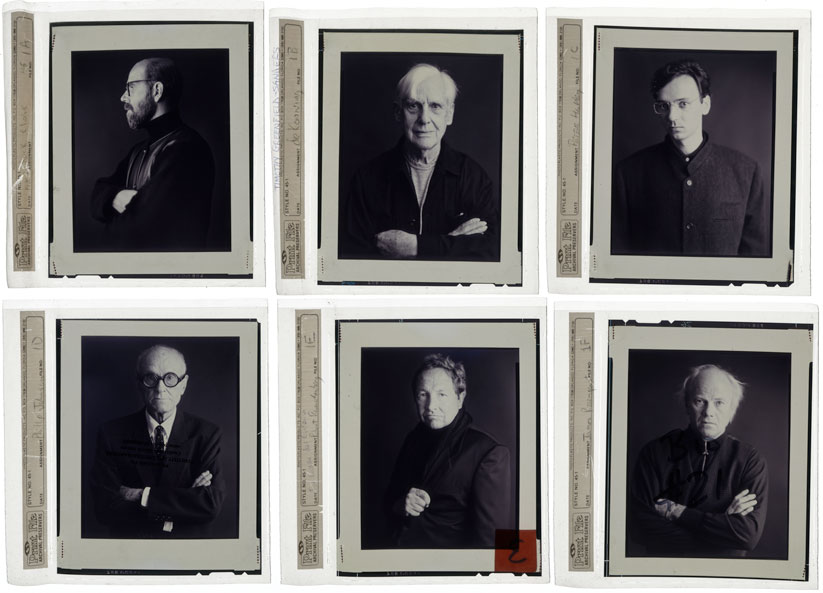
Only Hilton Kramer is able to defy these constraints, probably because of his indifference to visual culture, looking instead like a rich Republican collector at a supper party who has become exasperated because none of the artists there will agree with him that the poor actually flourished under Reagan. (I, should anyone be wondering, am to be found among the artists and look exactly as I did nearly 15 years ago.)
I thought the usefulness of Art World so striking, because it confirms so much that we know and will want to pass on to future generations, that I was surprised to see that Jerry Saltz, the art critic of the Village Voice, didn’t like the show at all. My attention was piqued, moreover, when I learned that he was the only person of whom I’d ever heard who had been reluctant to have Greenfield-Sanders photograph him.
However, beyond understanding that he feels that Greenfield-Sanders has made him look plump, I could not grasp what it was that he felt the photographs lacked. It’s difficult to know what Jerry wants because he belongs to that art critical tendency in which one speaks authoritatively while making wholly unqualified assertions, the canonical example of which is Donald Judd on Pollock, where all other writers on the topic are dismissed as dealing only in generalizations as the prologue to a discussion which deals in nothing else.
Faithful to this mode of argumentation, Saltz describes some of the photographs as “pointlessly” blurry but doesn’t tell us what’s pointless about it. The suggestion seems to be that it is a pointlessness that does not have a logical correlative in works which are “pointlessly” focused, but rather that photographs are meant to be objectively truthful in some way that requires them to be clear, definition being equivalent to the truth.
It is a very critical kind of truth he has in mind then, one which has to do with defining, and thus by implication with discourse and analysis. It is perhaps with this metaphysical ambition in mind that Saltz compares Greenfield-Sanders’ photographs to those of the pre-war German photographer August Sander. The comparison seems apt and promising, in that Sander too photographed people according to their trades who were also bound by strong cultural links.
However, Saltz does nothing with this comparison except to advance the ridiculous idea that Sander’s photographs tell me all I need to know about the psychological and social predispositions of rural and semi-rural individuals in northeast Germany in the years between the world wars, while Greenfield-Sanders’ need supplementation if one is to understand the contemporary art world.
This is ridiculous because any photograph requires supplementation to the extent that it is a document. If it were self-sufficient it wouldn’t be documenting something other than itself. It supplements, and is supplemented by, everything else one knows about what it depicts.
Unable to make sense of the comparison with Sanders as it is expressed, one supposes that the inadequacy Saltz perceives must have to do with the charge he levels at Greenfield-Sanders’ photographs when he says that, though he finds them unsatisfactory for the dubious reason stated above, they are the best description of the art world that we have, but unsatisfactory above all — that is to say, apart from when they’re pointless — because the photographer is a sycophant.
This seemed like a very strong word to me, and one very difficult to use in the art world context with any assurance that others might share one’s definition of it. I, for example, might once have been sympathetic to the notion that anyone who remembered a collector’s name was hopelessly sycophantic. And while I may no longer think this, it is a thought which led me to another when I saw Saltz use the word about Greenfield-Sanders, which is that sycophancy would of course be a charge with which a photographer would have to flirt while a critic could not.
People are hardly going to let one take their photograph if they think one hates or despises them, after all (unless that’s what’s in fashion). So one may say that being ingratiating is a professional requirement of the photographer, while an ingratiating critic is, on the other hand, an oxymoron.
A photographer, for example, might reasonably spend a lot of time with someone like Margaret Thatcher’s adman Charles Saatchi, and get some good photographs out of it. But a critic could not possibly do any such thing, or so I should think.
I wonder, then, if this is not the basis of Saltz’s complaint against Greenfield-Sanders. Photographers get to be uncritical — to adapt a favorite theme of mine — while critics must be critical. Photographers are professionally obliged to go to all the parties and be nice to everyone. Critics are obliged to be critical and for that reason must sometimes stay at home and read rather than going out and enjoying themselves without being sycophantic.
Could it be that Saltz’s objections to Greenfield-Sanders’ work reflect or express a certain impatience with the constraints of the aloof position his professional obligations require him to maintain? Perhaps this is why he likes Sander so much more than Greenfield-Sanders. It is that Prussian Pietism, so contemplative yet analytical (recalling as it does that Kant himself came from around there) that appeals to Saltz. In the future I shall read him — particularly with regard to the art he recommends — with this in mind, perhaps with Greenfield-Sanders portrait close to hand, but if so while making allowances for weight.
In the meantime I feel obliged to return to my opening sentences, where I suggested that Greenfield-Sanders is a documentary artist who inveigles his subjects into giving themselves away. Only charm could achieve such an effect, and the implication of that is that the photographer would be the one tradesman in the art market regarding whom the charge of sycophancy could never be apposite in quite the way that it might on any occasion be of any other participant in the historic flow.
This is probably why criticism, particularly of the authoritative sort de rigueur in the art world, has in contradistinction such a dependence on distance. Which it of course always proudly maintains with an absolutely Prussian sense of modest rectitude.
JEREMY GILBERT-ROLFE is a painter. His latest book, Beauty and the Contemporary Sublime, is forthcoming from Allworth Press in New York.
Related story: MEMORY LANE by Jerry Saltz
In the bookstore:
Art World by Timothy Greenfield-Sanders
©2000 artnet.com All rights reserved. Artnet.com is a registered trademark of the
ArtNet Worldwide Corporation, New York, NY. Terms and Conditions
